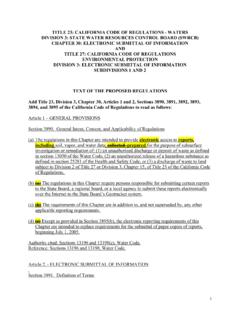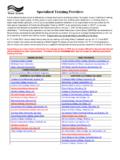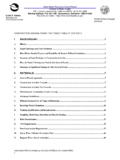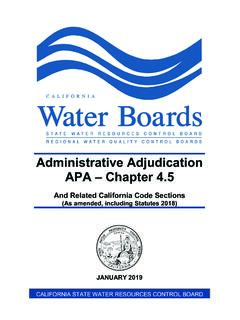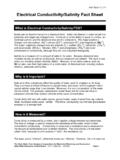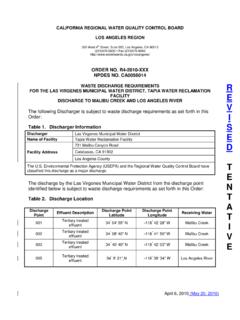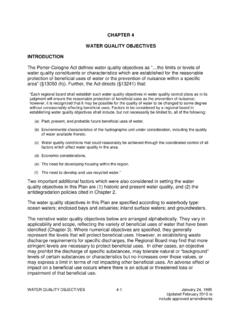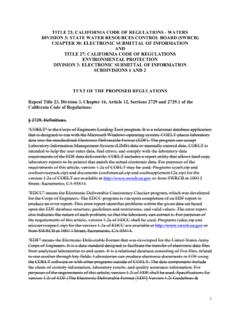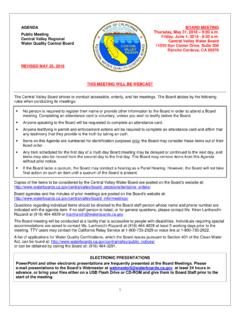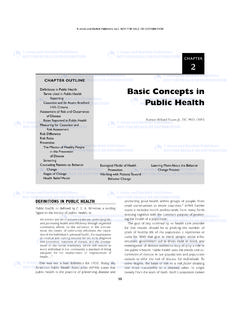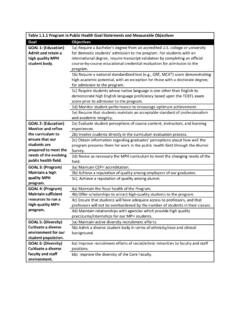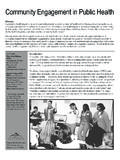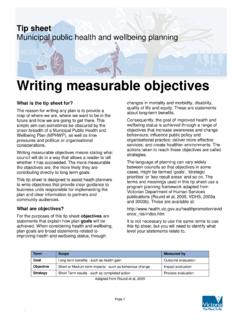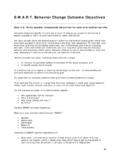Transcription of Frequently Asked Questions about Hexavalent Chromium in ...
1 Frequently Asked Questions about Hexavalent Chromium in Drinking Water On July 1, 2014 the State Water Resources Control Board s (State Water Board) maximum contaminant level (MCL) for Hexavalent Chromium , or Chromium -6, in drinking water took effect -- making California the first state in the nation to have an MCL for Hexavalent Chromium . The MCL for Hexavalent Chromium in drinking water is 10 parts per billion (ppb). By law, California is required to adopt drinking water standards that are no less stringent than the United States Environmental Protection Agency s federal standards. In addition, in the absence of a federal standard, California may establish its own drinking water standards. A drinking water standard, called a maximum contaminant level (MCL), establishes a limit on the concentration of a contaminant in drinking water.
2 MCLs are typically set at concentrations of parts per million (ppm) or parts per billion (ppb). Currently, there is no federal or state MCL specific to the Hexavalent form of Chromium . Hexavalent Chromium is regulated in drinking water through the establishment of a Total Chromium MCL ( Hexavalent Chromium is one of the forms of Chromium making up Total Chromium ). In California, the Total Chromium MCL is 50 ppb, while the federal MCL is 100 ppb. At the time Total Chromium MCLs were established, ingested Hexavalent Chromium associated with consumption of drinking water was not considered to pose a cancer risk, as is now the case. The State Water Board is required by California law to set an MCL for Hexavalent Chromium and to set the MCL as close to the public health goal (PHG) as possible, taking into account technical feasibility ( , detectability and treatment) and costs.
3 So, although the State Water Board has been gathering data associated with Hexavalent Chromium occurrence, treatment, and costs, adoption of an MCL requires the state Office of Environmental health Hazard Assessment (OEHHA) to establish a PHG. The Office of Environmental health Hazard Assessment s ppb PHG was finalized on July 27, 2011. What is Hexavalent Chromium and why is there a public health concern? Chromium is a heavy metal that occurs throughout the environment. The Trivalent form is a required nutrient and has very low toxicity. The Hexavalent form, also commonly known as Chromium -6, is more toxic and has been known to cause cancer when inhaled. In recent scientific studies in laboratory animals, Hexavalent Chromium has also been linked to cancer when ingested. Where does Hexavalent Chromium come from? Much of the low level Hexavalent Chromium found in drinking water is naturally occurring, reflecting its presence in geological formations throughout the state.
4 However, there are areas of contamination in California from historic industrial use, such as the manufacturing of textile dyes, wood preservation, leather tanning, and anti-corrosion coatings, where Hexavalent Chromium contaminated waste has migrated into the underlying groundwater. How was Hexavalent Chromium regulated in drinking water before the MCL? Hexavalent Chromium in drinking water is regulated under the Total Chromium state MCL of 50 ppb. The Total Chromium MCL was established in 1977, but includes the less-toxic Trivalent form. The other states used the total Chromium federal MCL of 100 ppb to regulate Hexavalent Chromium . What is a public health goal (PHG)? A PHG is a level of a contaminant in drinking that does not pose a significant health risk. A PHG reflects the risk from long-term exposure to a contaminant and should not be used to estimate risks from short-term or acute exposure.
5 PHGs are not regulatory requirements, but instead represent non-mandatory goals . public health goals are developed by OEHHA for use by the State Water Board in establishing MCLs. What is a State maximum contaminant level (MCL)? State MCLs are health protective drinking water standards to be met by public water systems. MCLs take into account not only health risks from exposure to a chemical, but also factors such as detectability and treatability, as well as costs of treatment to reduce a chemical s presence in drinking water. health & Safety Code 116365(a) requires the State Water Board to establish a contaminant's MCL at a level as close to its PHG as is technically and economically feasible, placing primary emphasis on the protection of public health . How do we establish the MCL levels? The first goal of the State Water Board is to try to establish an MCL as close as possible to the PHG.
6 This is a complex task as there are many factors to consider. Therefore, the State Water Board must create several possible MCLs to help estimate cost-benefit increases for levels of treatment. These proposed MCLs can be created by knowing: What different contaminant levels are found throughout water systems in California? What are the population sizes that are being affected/ exposed? What science is available to us to treat our water? What is the cost of the treatment to treat and monitor our water? What amount of health benefit is achieved at each increment? From the list of possible MCLs, the final MCL is chosen. How is Hexavalent Chromium currently regulated in drinking water? On July 1, 2014, California adopted the first drinking water standard for Chromium 6 in the nation. The MCL for Hexavalent Chromium in drinking water is 10 ppb.
7 At this time, the rest of the United States continues to use the Total Chromium federal MCL of 100 ppb to regulate Hexavalent Chromium . Why is the MCL for Hexavalent Chromium more health protective than the current Total Chromium MCL? Before July 1, 2014, Hexavalent Chromium in drinking water was regulated under the State s Total Chromium MCL of 50 ppb, which includes both Trivalent and Hexavalent Chromium . The less soluble Trivalent form is a required nutrient with very low toxicity, while the more soluble Hexavalent form may pose a risk of cancer when ingested. The new MCL provides public health protection specific to the more toxic Hexavalent form of Chromium . If my drinking water has Hexavalent Chromium above the PHG, is there a risk to my health ? A drinking water sample with a detection of Hexavalent Chromium above the PHG of ppb does not necessarily represent a public health concern.
8 The PHG is based on a cancer risk of no more than one case of cancer per one million people. The PHG tries to account for persons at three different stages in their lives by including protection factors to account for age and by applying higher rates of water consumption in their calculation. The PHG represents the level of Hexavalent Chromium at which no adverse health effects would be anticipated over an entire lifetime of exposure to the most sensitive population. So, a PHG is not a boundary line between a safe and dangerous level of a chemical, and drinking water is Frequently demonstrated as safe to drink even if it contains chemicals at levels exceeding their PHGs. OEHHA provides additional information on potential health risks and its PHG on its website. Now that California has the only MCL is the nation for Hexavalent Chromium , is the State Water Board done?
9 Some water systems are still being challenged by the Chromium -6 drinking water standard. Senate Bill SB 385 was signed into law to authorize the State Water Board to grant a limited period of time for affected water systems to work toward achieving compliance without being deemed in violation as long as strict safeguards are met. In addition, the State Water Board reviews every MCL at least once every five years to take into consideration new available technologies and potential health /cost benefits. (This FAQ sheet was last updated on Sept. 25, 2015)
